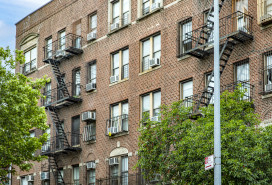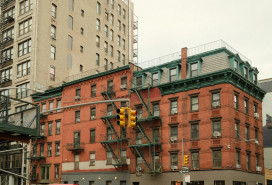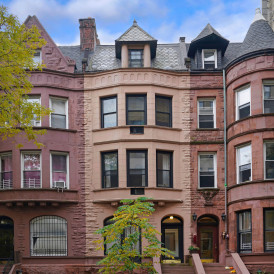Median sales price for Manhattan new condos jumped nearly 20 percent in the fourth quarter
- Sales of Manhattan co-op and condos rose 3.7 percent annually as per the Elliman Report

“The success story of Manhattan real estate over the last year has been the luxury and new development market,” said Jonathan Miller of Miller Samuel. There's strong demand for Downtown condos.
iStock
The Manhattan co-op and condo sales market ended the year with another annual increase in deals. It’s a continuation of a “normalizing” trend that began in the summer and is expected to continue in the new year.
Sales rose annually in the fourth quarter of 2024, increasing 3.7 percent, according to the latest edition of the Elliman Report. It was the second time in three quarters the market saw an annual increase. In the third quarter, Manhattan apartment sales were up by 6.7 percent year over year.
The median sales price for Manhattan co-op and condos dropped year over year for the fourth time, falling 4.9 percent to $1,100,000, the report said. But that doesn’t tell the full story: The median sales price for new condos was up 19.9 percent to $2,427,500, while the median price for resales was down 8.1 percent to $965,285.
“The success story of Manhattan real estate over the last year has been the luxury and new development market, which also skews luxury,” said Jonathan Miller, president and CEO of appraisal firm Miller Samuel and author of the report. “Those markets were less impacted by higher mortgage rates and are more dependent on cash buyers and financial markets, which have been robust.”
‘Getting back to zero’
Miller is known for summing up the year for the New York City real estate market in a few words. He called 2023, “the year of disappointment,” which was followed by 2024, “the year of less disappointment.”
This year’s nickname is more of a mouthful: 2025 is “the year of getting back to zero,” he said.
That’s a nod to how long high mortgage rates have been an issue: since the Fed pivoted to rate hikes starting in 2022, Miller said. The difference is that in 2025, buyers have a “more realistic understanding of how mortgage rates work,” he said.
“Rates are not going to drop significantly. I think sales are going to increase to more normal levels despite high mortgage rates. Buyers are sick of waiting for mortgage rates to fall,” he said.
Falling inventory
Manhattan listings were down 3.9 percent in the fourth quarter, the sixth quarter out of seven to see a drop in inventory, the report said.
In the last four quarters, the Manhattan market has been “faster,” Miller said, a reference to how much inventory is available. In the first quarter, there was 10.4 months of supply, meaning how long it would take to sell all available apartments for sale. (When months of supply drops below six months, it can be considered a seller's market.) In the second quarter, it was 9.2 months; in the third quarter, it was 7.8 months; and in the fourth quarter, 7.4 months.
Despite tighter inventory, sellers were negotiable. The listing discount, meaning the average discount that buyers negotiate off the asking price, was 9.2 percent in the fourth quarter, up from 5.8 in the previous quarter.
The increase in the listing discount means that sellers came down in price to meet buyers who are largely constrained in what they can pay by high mortgage rates, Miller said.
Downtown demand
Compass also released its fourth quarter Manhattan market report, which noted that an increase in contract activity was driven exclusively by condo deals. Downtown Manhattan continued to have most of the activity and modest year-over-year transaction growth, the report said.
“Buyers have accepted the new normal related to higher interest rates,” said Leonard Steinberg, chief evangelist and corporate broker at Compass. “The biggest inventory issue in Downtown Manhattan is that everyone wants what they want, which makes the most desired properties rise in price.”
“Downtown is where everyone wants to be,” said Daniel Blatman, an agent at Compass. “You have empty nesters moving downtown from the Upper East Side and Upper West Side, pied-á-terres, walkable neighborhoods, and first-time buyers wanting to buy where they go out.”
In the fourth quarter market report for SERHANT, Coury Napier, director of research, noted that “Downtown accounted for 25.7 percent of sales this quarter, with drastically different units closing compared to this time last year. These properties were 14.6 percent bigger on average and commanded a higher price, accordingly but were only slightly less affordable.”
Napier noted that Midtown East commanded the second-largest share of deals, “but smaller units traded hands for significantly lower prices on average,” he said.
But the cool kids want to be in Brooklyn
In his fourth quarter Manhattan sales report for Coldwell Banker Warburg, Frederick Warburg Peters, president emeritus, looked at the impact of changing preferences for NYC real estate. In the $4 million and up category, condos outsell co-ops of a rate of at least three to one as buyers opt for highly amenitized buildings with high ceilings, spacious rooms and layouts that rival prewar buildings.
Peters noted that Gen X and Millennial buyers are less interested in “status” properties on Park and Fifth avenues than their parents. Accordingly, “the overall flight of younger people from Manhattan into Brooklyn continues unabated.”
“While buyers above 59th Street on both the East and West sides still enjoy proximity to Central Park and many of the city’s best private schools, these neighborhoods ... just no longer seem cool,” he wrote.
Shorter marketing times
“Stronger demand and higher inventory have … led to quicker marketing times,” Pamela Liebman, president and CEO of Corcoran, noted in her firm’s fourth quarter Manhattan market report. As a result, days on market fell for a second, consecutive quarter to its lowest fourth-quarter average in three years.
Liebman said the fourth quarter was an “important test” for the Manhattan sales market.
“Despite the headwinds of the election, intensifying world events, lower yet fluctuating mortgage rates, and tighter supply, sales improved,” she said.
‘Reasons for optimism’
Looking ahead to 2025, Bess Freedman, CEO of Brown Harris Stevens, said in her firm’s fourth quarter Manhattan market report that the stock market’s great 2024 should help keep demand strong. Wall Street bonuses are expected to be similar to 2024, when $33.8 billion was paid out.
Freedman said the economy may not do as well in 2025 as it performed in 2024, but “we still expect steady growth.”
“Manhattan continues to have a healthy level of supply, which should keep prices stable in 2025, unlike many housing markets in the U.S.,” she added.
You Might Also Like




























